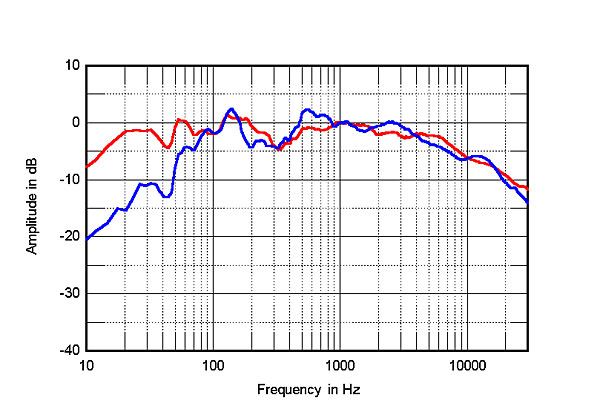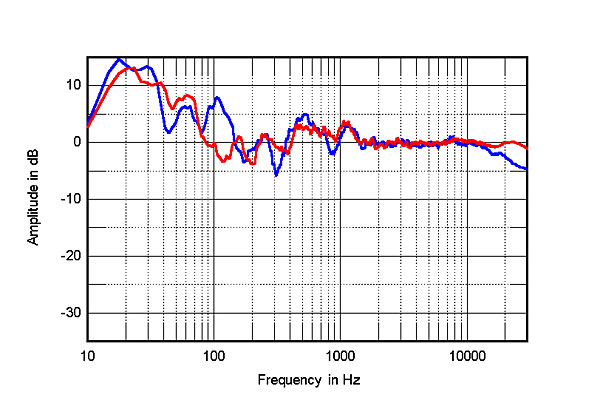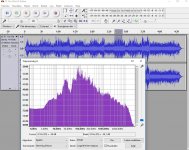Regarding 20-40Hz performance in OB, it is possible. A pair of good 15"s will produce decent SPLs down to 25Hz in a UK living room (not as big as the ones in the US). I'd like to try 2x15" (or even 4x15, why not?) a side some time, but that'll be a while off.
The key effect is that dipole systems do not excite a room in the same way as monopole systems. I found that I was applying EQ to counteract the OB rolloff, but no room EQ. The room I tested in has a +10dB spike at 38-41Hz, but the EQ I needed to apply was a smooth boost towards the low-frequency cutoff. The same drivers in sealed boxes needed lots of narrow-band cuts to get close to acceptable.
The sealed boxes would happily annihilate the OBs in outright SPL, but they're much more sensitive to the room's influence. Those that do not require extreme SPLs, but are happy to use fairly large speakers, will find dipole bass useful. It isn't for everyone.
Chris
The key effect is that dipole systems do not excite a room in the same way as monopole systems. I found that I was applying EQ to counteract the OB rolloff, but no room EQ. The room I tested in has a +10dB spike at 38-41Hz, but the EQ I needed to apply was a smooth boost towards the low-frequency cutoff. The same drivers in sealed boxes needed lots of narrow-band cuts to get close to acceptable.
The sealed boxes would happily annihilate the OBs in outright SPL, but they're much more sensitive to the room's influence. Those that do not require extreme SPLs, but are happy to use fairly large speakers, will find dipole bass useful. It isn't for everyone.
Chris
Yes, place it directly behind you back, 1 or 2 ft at max. Good bass with impact down to 20Hz (albeit with much less room boom and with much less rattling furniture) from OB requires listening in the proximity sound field unless you want go crazy with cone area.Let's say i put a 18FH500 on a 4'x8' wood panel, can i expect to have everything for a fair comparison with my ''real'' subwoofers ?
Come on let's not be vague in order to squeeze out more performance from OB's than physically possible: it depends on baffle width when canceling starts, and by a bit more than a few dB per octave. I'd say 6 dB per octave below Fs and another 6 dB per octave because of canceling.
The curve drops away by at least 12 dB / octave in theory.
Practically, with proper placement and room gain into the mix you might reduce the loss just a bit.
Need to correct 😀.
Dipole loss is 6 dB / octave in theory.
Compared to monopole, dipole loss in the lowest octave (with substantial baffle width) easily reaches 12 dB or more. This has to be equalized somehow.
Practically other factors might have influence, Qt for example (read Linkwitz).
Need to correct 😀.
Dipole loss is 6 dB / octave in theory.
Compared to monopole, dipole loss in the lowest octave (with substantial baffle width) easily reaches 12 dB or more. This has to be equalized somehow.
Practically other factors might have influence, Qt for example (read Linkwitz).
All OB drivers will fall at 18dB/octave below Fs. That's 12dB/octave due to driver operating below Fs, and 6dB/octave dipole losses. Qts defines the shape of the rolloff due to the driver. A low-Q driver will start rolling off early, but will be well below Fs before it reaches 12dB/octave. Think Bessel filter. A high-Q driver will be more like Butterworth, much sharper corner and then a pretty immediate rolloff.
Chris
Come on let's not be vague in order to squeeze out more performance from OB's than physically possible: it depends on baffle width when canceling starts, and by a bit more than a few dB per octave. I'd say 6 dB per octave below Fs and another 6 dB per octave because of canceling.
The curve drops away by at least 12 dB / octave in theory.
Practically, with proper placement and room gain into the mix you might reduce the loss just a bit.
Sorry I forgot the smiley. But any speaker will have a baffle loss, and the OB will have 6 dB on top of that down to Fs, and below Fs it's even steeper.
If you will make a passive crossover, then there are woofers dedicated to OB, and the loss is compensated in the T/S parameters.
If you go active, then any good woofer with high Xmax and good mechanical design without noise will be a good woofer. You will ofcourse sacrifice the higher efficiency in order to get a flat respons to 30-40 Hz.
If you choose a closed box, and need deep bass without much eq, then you need a very large box. To me that is also a tradeof.
OB = huge woofer
Closed box = huge box
Last edited:
I listen very quick & dirty DBA few last days.The bass is better because it's thinnier! That's the secret.
Low (20-50+ Hz) bass seems bester 😀 (sorry for non-existent word)
...
OB = huge woofer
Closed box = huge box
False! If we want to get 20Hz flat in-room:
Closed box = medium box and huge power
BR box = huge box
Magico S5 in-room (red)

vs. Beolab 90 with dsp

Last edited:
Without saying you wisch to have lowFs from the nude driver as well despite the room modes ?!
Maybe ripole sub design help a little : in theory with the good driver you can have a -10 db Fs ! But all the ripoles users testimonied for less slam than a sealed or vented design. Good enough for music though (not (Star) war movies)!
But hey, there are not too much music below 30 Hz : do you all listen grand orgue at 18/20 Hz or many piano partition with the lowest 28.5 Hz note ?
On the paper I like the Ripole as build here for instance : http://jazzman-esl-page.blogspot.fr/2011/01/ripole-subs-are-underway.html low foot print, counter force cancelation (?) ! But has it the slam of a JBL driver ??? not sure ! Better "readibility"... maybe ! I assume it's also about what you listen to : classical or Rock ! Rock sounds often good with higher QTc, not classical according to my little experience !
I surmise ripole subs to have a big roll off !
Maybe ripole sub design help a little : in theory with the good driver you can have a -10 db Fs ! But all the ripoles users testimonied for less slam than a sealed or vented design. Good enough for music though (not (Star) war movies)!
But hey, there are not too much music below 30 Hz : do you all listen grand orgue at 18/20 Hz or many piano partition with the lowest 28.5 Hz note ?
On the paper I like the Ripole as build here for instance : http://jazzman-esl-page.blogspot.fr/2011/01/ripole-subs-are-underway.html low foot print, counter force cancelation (?) ! But has it the slam of a JBL driver ??? not sure ! Better "readibility"... maybe ! I assume it's also about what you listen to : classical or Rock ! Rock sounds often good with higher QTc, not classical according to my little experience !
I surmise ripole subs to have a big roll off !
Last edited:
False! If we want to get 20Hz flat in-room:
Closed box = medium box and huge power
BR box = huge box
What exactly is false?
If you are building a closed box without eq (maybe some baffle step correction, but no DSP) and need to go low, then you need a large closed box.
If you put a large driver in a small box, you will need eq.
An OB with a large woofer, and a fairly large baffle (but still no big box behind), will go pretty low even with passive correction.
I just wanted to point-out that any type of construction comes with a tradeof, and when you take the room in the equation it get's even more complex (or more fun)
But hey, there are not too much music below 30 Hz : do you all listen grand orgue at 18/20 Hz or many piano partition with the lowest 28.5 Hz note ?
Yes, and some electronic music also have very low bass.
... in rave parties these are the listeners whom are out of phase !
Maybe but here a simple car woofer with long excursion in a sealed enclosure should be good enough : the very low notes of electronic musics are not so often coming from (acoustical & rapid) percussions ! (and I also surmise it's good enough for grand orgue as it will be the room which will dictate the result ! the length of a 20 Hz note is far above our listen rooms...)
... without saying than your own ears/nervous sytem give you a subjective listening of - 40 to -60 dB at 20 Hz (in relation to the average level of the whole above spl (- 60 db at average 80 dB listening level in the mids) ! Bass is more "feeled" than "heared" at 20 Hz !
A good experience is to hear the lowisch notes in a long cathedral then on a PA Woofer : in the first you have more the feeling of clearness, articulation with echo if I can talk like this and in a room with a PA woofer, it's more thick with less articulation and more reverberation feeling than echos ! More Grand 8 in a Cathedral, more in a washing machine in a living room !
Maybe but here a simple car woofer with long excursion in a sealed enclosure should be good enough : the very low notes of electronic musics are not so often coming from (acoustical & rapid) percussions ! (and I also surmise it's good enough for grand orgue as it will be the room which will dictate the result ! the length of a 20 Hz note is far above our listen rooms...)
... without saying than your own ears/nervous sytem give you a subjective listening of - 40 to -60 dB at 20 Hz (in relation to the average level of the whole above spl (- 60 db at average 80 dB listening level in the mids) ! Bass is more "feeled" than "heared" at 20 Hz !
A good experience is to hear the lowisch notes in a long cathedral then on a PA Woofer : in the first you have more the feeling of clearness, articulation with echo if I can talk like this and in a room with a PA woofer, it's more thick with less articulation and more reverberation feeling than echos ! More Grand 8 in a Cathedral, more in a washing machine in a living room !
Last edited:
When I get my new speakers ready, I will have eight 10" woofers, maybe I should make eight subwoofers for 20-50 Hz - then my room resonances should be gone.
The the new OB's will take care og 50 - 20khz
The the new OB's will take care og 50 - 20khz
Some records of JJ Cale and Leonard Cohen have serious bass too.
Kjeldsen, check BR box parameters for a low tuned 12" driver and calculate pipe length!
Typical home listening rooms have lowest mode between 35 and 40Hz, and below that we get some pressurization. The roll-off Q of most closed boxes/drivers matches with room gain pretty well. Some studies in this thread http://www.htguide.com/forum/showth...ized-the-Dream&p=612403&viewfull=1#post612403

Kjeldsen, check BR box parameters for a low tuned 12" driver and calculate pipe length!
Typical home listening rooms have lowest mode between 35 and 40Hz, and below that we get some pressurization. The roll-off Q of most closed boxes/drivers matches with room gain pretty well. Some studies in this thread http://www.htguide.com/forum/showth...ized-the-Dream&p=612403&viewfull=1#post612403

Attachments
Yes, then over at my theater rue de la Vaquerie for the Kiron theater demos.Rue Belfort in Paris?
It's nice to see the discussion this morning with people finally saying if you want low bass, it's going to be big. Big baffle, big drivers, big box or big EQ. That's physics. And OB is going to be the biggest because of the rear wave cancellation.
FWIW, 12dB per octave should be the OB bass roll-off, but in room I find it closer to 9db/octave. John clued me into that, and I found it in my measurements. Not sure why that is. On some of my builds that holds until woofer Fs, then it drops like a stone. On others it does not drop off so fast under driver Fs. Don't know why - maybe baffle size.
@ Juhazi : typically -12 dB roll off ?
@ Pano : give us back to France the Altec system ... 🙂
I oftened read Hiraga (because I'm french) saying the same as you : physic ! Huge box with driver with huge Vas sound good ! I think it had also heard many systems in Japan with no compromises (huge systems)
(PS : like the Bafle Step : nearer than -3/4 dB than - 6 dB in a typical listening room ?!)
@ Pano : give us back to France the Altec system ... 🙂
I oftened read Hiraga (because I'm french) saying the same as you : physic ! Huge box with driver with huge Vas sound good ! I think it had also heard many systems in Japan with no compromises (huge systems)
(PS : like the Bafle Step : nearer than -3/4 dB than - 6 dB in a typical listening room ?!)
Last edited:
9dB/oct roll IRL could be because of floor acting as extended baffle
The simulation I linked has "boundaries" but still it is just simulation. OB will not benefit from pressurization at least not as much as closed boxes. BR will not benefit either, below tuning.
Simulations and theories vs. reality in small rooms make this low bass issue hard to understand and believe. In-room measurements have some reliability issues as well, when we must use long gating. Street noise, ventilation noise etc. is surprisingly high in level, measure with generous spl!
This is my 2x15" PPSL closed box subwoofer in a 11 m2 room (door open) nearfield vs at distance, mic on the floor. No eq used at all!
http://www.diyaudio.com/forums/subw...inet-subwoofer-2x15-closed-8.html#post3463101
The simulation I linked has "boundaries" but still it is just simulation. OB will not benefit from pressurization at least not as much as closed boxes. BR will not benefit either, below tuning.
Simulations and theories vs. reality in small rooms make this low bass issue hard to understand and believe. In-room measurements have some reliability issues as well, when we must use long gating. Street noise, ventilation noise etc. is surprisingly high in level, measure with generous spl!
This is my 2x15" PPSL closed box subwoofer in a 11 m2 room (door open) nearfield vs at distance, mic on the floor. No eq used at all!
http://www.diyaudio.com/forums/subw...inet-subwoofer-2x15-closed-8.html#post3463101
Attachments
Last edited:
arrays or several bass unit à la Gedlee ?
Several woofers. I read about it in a Danish magazine 20-25 years ago. They recommended 4 woofers in each corner, even better two more woofers in the middle, and ultimately 12 woofers with 6 on the floor and 6 on the ceiling (mirroring the woofers on the floor).
Yes, place it directly behind you back, 1 or 2 ft at max. Good bass with impact down to 20Hz (albeit with much less room boom and with much less rattling furniture) from OB requires listening in the proximity sound field unless you want go crazy with cone area.
😕
Sorry KSTR i don't follow... 1 or 2 ft. listening distance ?
Maybe but here a simple car woofer with long excursion in a sealed enclosure should be good enough : the very low notes of electronic musics are not so often coming from (acoustical & rapid) percussions ! (and I also surmise it's good enough for grand orgue as it will be the room which will dictate the result ! the length of a 20 Hz note is far above our listen rooms...)
1. There is musical content in the +/- 20-30hz region more than most people think.
2. Ok... what about the lenght of the 20hz in relation in our listening rooms ?
- Home
- Loudspeakers
- Multi-Way
- Open Baffle OR Baffle-less ?


